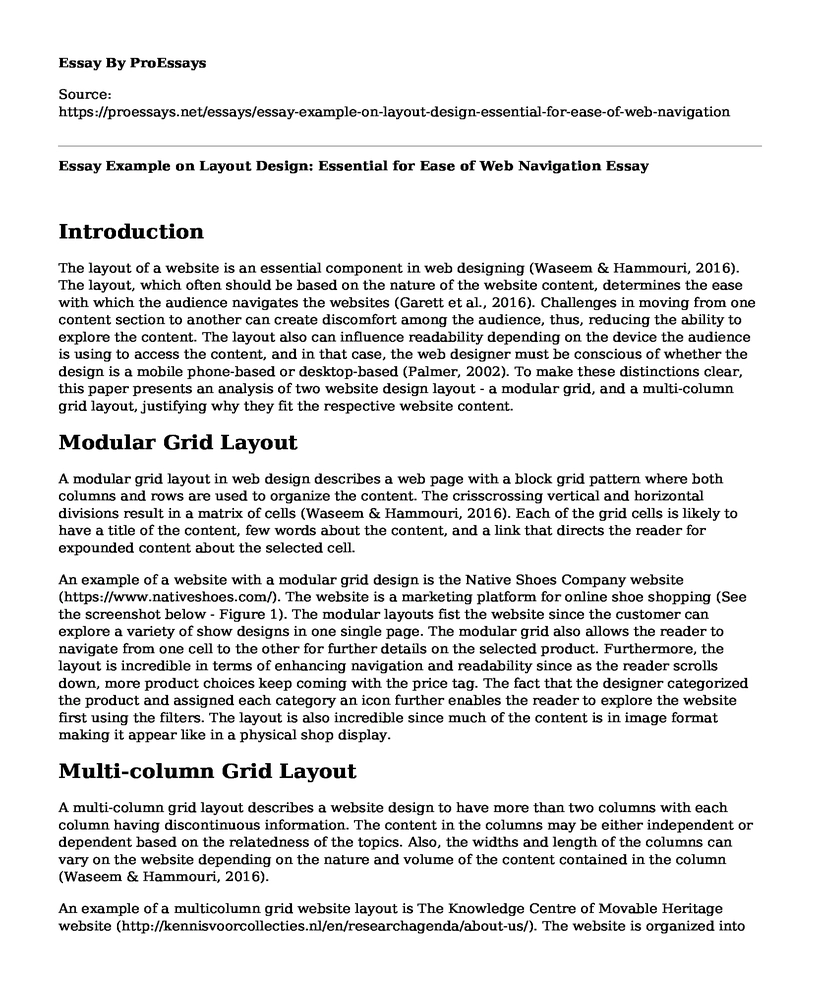Introduction
The layout of a website is an essential component in web designing (Waseem & Hammouri, 2016). The layout, which often should be based on the nature of the website content, determines the ease with which the audience navigates the websites (Garett et al., 2016). Challenges in moving from one content section to another can create discomfort among the audience, thus, reducing the ability to explore the content. The layout also can influence readability depending on the device the audience is using to access the content, and in that case, the web designer must be conscious of whether the design is a mobile phone-based or desktop-based (Palmer, 2002). To make these distinctions clear, this paper presents an analysis of two website design layout - a modular grid, and a multi-column grid layout, justifying why they fit the respective website content.
Modular Grid Layout
A modular grid layout in web design describes a web page with a block grid pattern where both columns and rows are used to organize the content. The crisscrossing vertical and horizontal divisions result in a matrix of cells (Waseem & Hammouri, 2016). Each of the grid cells is likely to have a title of the content, few words about the content, and a link that directs the reader for expounded content about the selected cell.
An example of a website with a modular grid design is the Native Shoes Company website (https://www.nativeshoes.com/). The website is a marketing platform for online shoe shopping (See the screenshot below - Figure 1). The modular layouts fist the website since the customer can explore a variety of show designs in one single page. The modular grid also allows the reader to navigate from one cell to the other for further details on the selected product. Furthermore, the layout is incredible in terms of enhancing navigation and readability since as the reader scrolls down, more product choices keep coming with the price tag. The fact that the designer categorized the product and assigned each category an icon further enables the reader to explore the website first using the filters. The layout is also incredible since much of the content is in image format making it appear like in a physical shop display.
Multi-column Grid Layout
A multi-column grid layout describes a website design to have more than two columns with each column having discontinuous information. The content in the columns may be either independent or dependent based on the relatedness of the topics. Also, the widths and length of the columns can vary on the website depending on the nature and volume of the content contained in the column (Waseem & Hammouri, 2016).
An example of a multicolumn grid website layout is The Knowledge Centre of Movable Heritage website (http://kennisvoorcollecties.nl/en/researchagenda/about-us/). The website is organized into multiple expandable columns (See Figure 2 below). The columns enhance the readability of the content given that each column has a heading and brief description of the content. Once the reader clicks on the column, it expands revealing the full content, also organized in columns. The fact that each column contains a distinct, yet related content promotes comprehension by reducing confusion on when the details begin or end. The combination of images and content makes the column layout stand out encouraging the reader to keep exploring the website.
Conclusion
In conclusion, the two websites settled on grid designs that are perfectly fit for the web content presented. The audience can easily navigate the websites with ease.
References
Garett, R., Chiu, J., Zhang, L., & Young, S. D. (2016). A literature review: website design and user engagement. Online Journal of Communication and Median Technologies, 6(3), 1-14.
Palmer, J.W. (2002). Website usability, design, and performance metrics. Information System Research.13(2); 151 - 167. doi: 10.1287/isre.13.2.151.88.
Waseem, I. B. & Hammouri, A.I. (2016). Responsive web design techniques. International Journal of Computer Applications. 150(2); 18 - 27
Cite this page
Essay Example on Layout Design: Essential for Ease of Web Navigation. (2023, Jun 11). Retrieved from https://proessays.net/essays/essay-example-on-layout-design-essential-for-ease-of-web-navigation
If you are the original author of this essay and no longer wish to have it published on the ProEssays website, please click below to request its removal:
- Web Design - Research Paper Example
- XML and XML-Enabled Databases Paper Example
- Springfield Site Challenges and Implementations Paper Example
- Protecting the Host Machine From Failure When It Exceeds Certain Limitations
- Personal Statement and Belief on Cybersecurity
- Digital Data Management: Privacy & Ethical Issues - Essay Sample
- Essay Example on the Sequoia Project: Advancing Reliable Data Exchange for Disaster Employees







